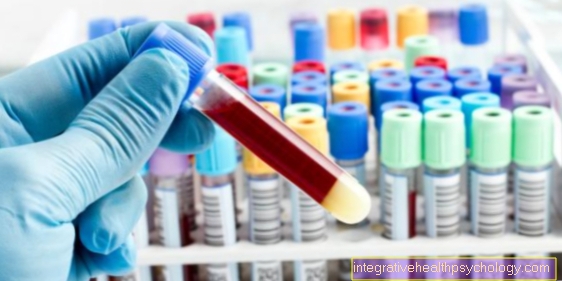
Cholinesterase is an enzyme (a substance that makes chemical reactions run faster in the body, usually a protein) and is produced in the liver. It plays an important role in the transmission of impulses from nerves to muscles, for example (see: motor end plate).
If the liver is damaged by any cause, the ability to produce is also disturbed and a cholinesterase deficiency occurs. Thus, by determining the cholinesterase in the blood, conclusions can be drawn about the liver function.

Since cholinesterase is made in the liver, its production can be restricted in a variety of liver damage, leading to a deficiency. This liver damage can occur, for example, from an overdose of the pain reliever paracetamol. In addition, diseases that damage liver cells such as inflammation of the liver (hepatitis), liver cirrhosis or liver cell cancer (hepatocellular carcinoma) can lead to a deficient production of cholinesterase. Not only liver cell cancer can have an impact on cholinesterase. In the case of a large number of tumor diseases, the patients become emaciated in advanced stages. This lack of physical reserves can also lead to reduced liver function and thus lead to a cholinesterase deficiency. Two kinds of poisoning can also damage the liver cells. These are poisonings with the death cap mushroom or with the insecticide E 605. There is also an innate form of cholinesterase deficiency.
$config[ads_text1] not found
Read more about the topic here: hepatitis
A cholinesterase deficiency alone cannot be recognized by disease-specific symptoms. If the cholinesterase is low due to a causal liver disease, a wide variety of symptoms can occur, which are more likely to be triggered by the liver disease than by the cholinesterase deficiency itself. These symptoms include, but are not limited to, yellowing of the skin of the eyes or skin (please refer: Jaundice), itching, bleeding, visible veins in the abdomen or an enlargement of the liver, which can be felt as a result. The symptoms mentioned do not always occur when the liver is damaged and are also not indicative of a cholinesterase deficiency.
Specific symptoms only occur if a patient with an as yet unknown cholinesterase deficiency is given a certain drug to relax the muscles under general anesthesia. The consequences and the causes are described in the following subsection.
Learn more about the topic at: Therapy for jaundice and cholinesterase inhibitors
In the case of anesthesia, medication to relax muscles is the standard. These cause the muscles in the body to become slack and thus facilitate ventilation during anesthesia and also the operation itself. A group of muscle relaxants (succinyl type) has the effect of relaxing the muscles by attaching to certain receptors on the muscle and overstimulating them. This overstimulation blocks further stimulation of the muscle and there is no further excitation of the muscle. This muscle relaxant is broken down by cholinesterase. This means that the cholinesterase breaks down the muscle relaxant that is bound to the muscle. Thereafter, the cleavage product is broken down through the blood. This mechanism causes the muscle relaxant to gradually lose its effect until normal excitability of the muscle is restored. If there is now a deficiency in cholinesterase, the muscle relaxant is broken down much more slowly. This information is important before performing anesthesia with ventilation, as you then use a different group of drugs to relax the muscles, as otherwise dangerous respiratory paralysis can occur, as the muscle that drives breathing (diaphragm) also comes from the muscle relaxant is blocked. This danger exists especially in the congenital type of cholinesterase deficiency.
$config[ads_text3] not found
Find out more about the topic here: Anesthetics
With local anesthesia, a cholinesterase deficiency has the consequence that certain local anesthetics are broken down more slowly. On the one hand, this results in prolonged anesthesia in the region, but the fact that the drug has a longer duration of action in the body can also lead to other side effects. If there is a deficiency in a related enzyme, namely pseudocholinesterase, the effect of local anesthesia can also be prolonged.
$config[ads_text2] not foundRead more on the topic: Side effects of local anesthesia and local anesthetic
In the case of cholinesterase deficiency, local anesthetics should be administered with caution or those that are broken down by another mechanism should be used. In addition, muscle relaxants that are not of the succinyl type should be used during anesthesia in order to prevent prolonged respiratory paralysis after the operation. In addition, other drugs such as the birth control pill, certain glaucoma drops, anticholinergics or high-dose glucocorticoids can have a negative effect.
Cholinesterase can be determined in the blood and this is how the diagnosis of cholinesterase deficiency is established. It is important to note here that the cholinesterase is lowered in the most common cases due to an underlying disease that is damaging to the liver. It is only with congenital cholinesterase deficiency that another clinical picture is not necessarily present at the same time. The normal values for cholinesterase are different for women and men, as well as children and pregnant women.
$config[ads_text4] not found
Find out more about the topic here: Increased liver values or Liver values